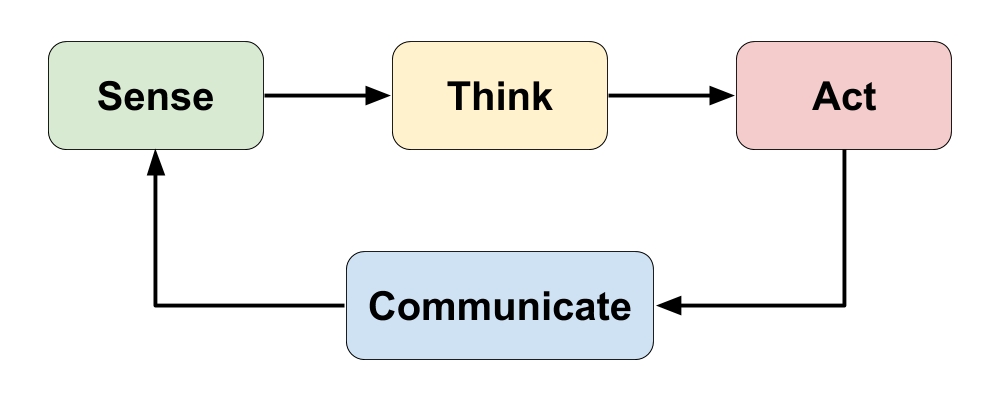2.2 System Model
Similar to robotic devices, IoT devices follow a "Sense-Think-Act" cycle to interact with the physical world. IoT devices also "communicate" through an internet or network connection.

SENSE: IoT devices typically have one or more physical inputs (such as sensors, etc.) that gather data from the physical environment.
THINK: IoT devices are programmed to analyze data from their inputs to make decisions and respond to certain conditions by acting through their outputs.
ACT: IoT devices typically have one or more physical outputs (such as motors, etc.) that can do something in the physical environment.
COMMUNICATE: IoT devices send and/or receive data by communicating with other apps, databases, or other devices through an internet or network connection (which is often a wireless signal such as cellular, Wi-Fi, Bluetooth, etc.). This data communication can serve as a digital input ("sense") or as a digital output ("act").
Your team will create a system model of your smart device and web app to show how the different parts of your solution will work together to "Sense-Think-Act-Communicate". This system model will help your team better understand how to build your smart device and program its apps.
REFINE PROJECT CONCEPT: Before your team finalizes its system model, your team might need to revise or refine its project concept based on the feedback you received during your proposal presentation.
Be sure you can build a functional prototype of your smart device that can be demonstrated to the public. If necessary, you can simulate certain parts or actions as long as the main task of your smart device can still be demonstrated.
REMINDER: The project challenge requires that your smart device prototype uses at least one physical input (sensor, button, etc.) and at least one physical output (motor, LED light, etc.) from the provided IoT electronics kit.
Make a copy of this system model template, and then modify it:
Identify the name of each physical input (sensor, push button, etc.) that your smart device will use, and describe how each input will be used.
Identify the name of each physical output (motor, LED light, etc.) that your smart device will use, and describe how each output will be used.
Describe each task or feature of the web app that interacts with your smart device.
NOTE: Although this system model won't directly list the "Think" steps performed by your smart device's apps, these "Think" steps should be clearly implied by your descriptions for the inputs, outputs, and web app.
❏ Deliverable
Submit your team's system model for your smart device solution.

✓- Below Standard
✓ Meets Standard
✓+ Exceeds Standard
Description
Description
Description